- 1School of Nursing and Midwifery, College of Health and Medical Sciences, Jigjiga University, Jigjiga, Ethiopia
- 2School of Nursing and Midwifery, College of Health and Medical Sciences, Haramaya University, Harar, Ethiopia
- 3School of Medicine, Institute of Health, Jigjiga University, Jigjiga, Ethiopia
- 4St. Peter’s Specialized Hospital, Addia Ababa, Ethiopia
- 5Department of Epidemiology, School of Public Health, College of Health and Medical Sciences, Dilla University, Dilla, Ethiopia
Background: Currently, patient satisfaction is a major concern in the healthcare system of Ethiopia. Patient satisfaction with nursing care is considered an important factor in explaining patients’ service quality. Satisfied patients are more likely to have a good relationship with nurses, which suggests improved quality of care.
Objective: To assess the prevalence of patient satisfaction and its associated factors among admitted patients in Addis Ababa city public referral hospitals, Ethiopia 2023.
Methods and materials: An institutional-based cross-sectional study design was employed among 471 randomly selected patients from June 1 to July 30, 2023. Interviewer-administered a structured questionnaire was used to collect data. Patient satisfaction was measured by using the Newcastle Nursing Care Satisfaction Scale. Bivariable and multivariable logistic regressions were used to identify the factors associated with patient satisfaction.
Result: 471 participants responded among 506 selected patients yielding a response rate of 93%. The satisfaction of patients was 47.8% (95% CI = 42.9, 52.2%) Multiple logistic regression showed that participants aged 26–35 were less likely to be satisfied with nursing care [AOR = 0.25, 95% CI: 0.11, 0.56]. In contrast, those in the surgical ward [AOR = 3.85, 95% CI: 1.98, 7.45] and ophthalmology ward [AOR = 4.27, 95% CI: 1.81, 10.05] were more satisfied. No previous admission [AOR = 0.13, 95% CI: 0.07, 0.26], having no comorbidities [AOR = 13.4, 95% CI: 7.06, 25.4], and shorter admission duration [AOR = 9.14, 95% CI: 3.46, 24.11] were found to be factors with a significant association with patient nursing satisfaction.
Conclusion: Overall, just under one in every two admitted patients were satisfied, indicating areas for potential improvement in nursing care. Specific factors such as patients in the age range of 26 to 35 reported significantly lower levels of satisfaction, whereas patients in the surgical and ophthalmology wards, as well as those without comorbidities and with shorter hospital stays, reported significantly higher levels of satisfaction. These findings emphasize the importance of targeted strategies to enhance nursing care.
Background
Patient satisfaction is defined as the patient’s judgment on the quality of care in all aspects, particularly concerning the interpersonal process. Based on Andrea Eisenberg, 2020 patient satisfaction defined as a measure of how happy a patient is with their healthcare (1, 2). It is related to technical and interpersonal behavior, partnership building, immediate and positive nonverbal behavior, more social observation, courtesy, consideration, clear communication and information provision, respectful treatment, frequency of contact, length of consultation, service availability, and waiting time (3, 4).
Nurses and nursing care are very pertinent components of any healthcare system. It is a multidimensional concept that has the following aspects: the art of care, the technical quality of care convenience, cost, physical and environmental organization, availability of the resource, continuity of care, and outcomes (5, 6). Nursing symbolizes the art of care. Nurses provide emotional support, comfort, and advocacy for patients during often vulnerable times. Their ability to listen attentively, build rapport, and explain complex medical information clearly and compassionately is crucial for patient well-being (7). Additionally, nursing care is grounded in the technical quality of healthcare. Nurses are skilled professionals with a wide range of knowledge. They conduct thorough health assessments, create personalized care plans, perform nursing procedures, and provide patient education (8, 9).
Patients can assess the healthcare practitioners and services from their subjective perspective, even while they are unable to determine certain technical features. They are the best source of accurate information regarding clarity of explanations, the kindness of information they are receiving, barriers to obtaining care, or the nurse’s interpersonal behavior (10, 11). Patient satisfaction has been used as a significant indicator of quality services provided by healthcare personnel (9). As a result, patients’ satisfaction with nursing care is a significant factor influencing their overall satisfaction with health facility services (12–14). In Ethiopia, despite the Ethiopian Federal Ministry of Health develop various national quality management guidelines to enhance patient satisfaction, studies indicate that significant challenges persist in effectively implementing these guidelines (15, 16). A systematic review by Mulugeta et al. analyzed 15 studies and revealed a pooled prevalence of patient satisfaction with nursing care in Ethiopia was 55.15% (5).
Patient satisfaction with nursing care is related to the quality of nursing care (5). By exploring the levels of patient satisfaction, we can get insights into various aspects of the nursing services they receive. This feedback can highlight positive areas such as effective communication, empathy, and responsiveness, as well as areas needing improvement in overall patient engagement. Furthermore, by analyzing patient satisfaction, healthcare facilities can identify patterns and trends that inform quality improvement initiatives.
Even though this topic has been the subject of several studies in Ethiopia as well as globally, the results are still inconclusive and contradictory (17). Specifically in Ethiopia, almost all studies are limited to single health facilities that are set in the countryside (15, 18–20). The Ethiopian civil service reform strategy has been implemented in all hospitals to enhance service provision for the community (21). Based on this fact, it is crucial to understand the satisfaction levels of patients admitted to wards with more health facilities in Addis Ababa, where patients come from diverse regions using standard measurement tools to ensure reliable data. Additionally, a limited study was conducted on patient satisfaction with nursing care services in the country’s largest referral hospitals, which serve patients from a variety of regions. Therefore, this study is intended to assess the level of patient satisfaction and associated factors toward nursing care in Public Referral Hospitals of Addis Ababa, Ethiopia.
Materials and methods
This study was conducted following principles outlined in the Strengthening the Reporting of Observational Studies in Epidemiology (STROBE) guidelines (22), ensuring rigor, transparency, and completeness in the reporting of our methodology and findings.
Study design, population, and sample
An institutional-based cross-sectional study was conducted from June 1 to July 30, 2023, in two randomly selected public referral hospitals in Addis Ababa. The study population consisted of all admitted adult patients in these hospitals who met the inclusion criteria and provided consent to participate.
The sample size was determined using a single population formula, based on the assumption that the prevalence of patient nursing satisfaction is 49.2%, as reported in a study conducted at Debre Berhan Referral Hospital in Ethiopia (19). A 95% confidence level and a 5% margin of error (d) were applied. After accounting for a 10% non-response rate and a design effect of 1.5, the final sample size was calculated to be 506.
Inclusion and exclusion criteria
All adult patients admitted for more than 24 h at the selected hospitals during the study period were included in the study. Patients who were seriously ill or unconscious at the time of data collection period were excluded from the study.
Instruments and operational definition of variables
The Newcastle Nursing Care Satisfaction Scale (NSNS) was used to measure patient satisfaction. The satisfaction subscale assesses satisfaction with all aspects of nursing care using 19 items rated on a 5-point Likert scale (Not at All Satisfied, Barely Satisfied, Quite Satisfied, Very Satisfied, Completely Satisfied). The NSNS tool demonstrated excellent reliability with a Cronbach’s α of 0.96 from previous studies. A satisfaction sum score for each patient was calculated, and the mean score was used to dichotomize satisfaction into satisfied and unsatisfied. Based on this, the following definitions were made:
Satisfied: The mean score of the patient’s Newcastle Nursing Care Satisfaction Scale was 38.32. Respondents who scored above the mean value were regarded as satisfied with nursing practices.
Unsatisfied: Patients who scored below the mean on the Newcastle Nursing Care Satisfaction Scale were regarded as unsatisfied with nursing practices.
Sampling procedure
Multistage sampling was used to get the study participants. The first two public referral hospitals were selected randomly after which the sample size (506) was allocated by probability proportional to size (PPS) considering their last one-month admission coverage before data collection. Again, this number was reallocated proportionally to the different wards of the selected hospitals excluding pediatric and neonatal admission wards. Systematic random sampling was employed to select the study participants from their sequence of admission registration during the study period. Every two admitted patients were considered for participation and the first patient was selected randomly at the beginning of the study. The sampling interval (K) was calculated by dividing the total sample size by the allocated sample size for each hospital. Similar approaches were applied to get the study participants in the selected wards.
Data collection tools and procedure
Data collection instrument
Data were acquired through a structured, pre-tested, and interviewer-administered questionnaire which was developed by reviewing different literature. These carefully designed questionnaires encompass various sections, with Part I: focusing on the socio-demographic variables of the participant. Part II: Questions contained admission characteristics of the patient, and Part III: Questions to assess patients’ satisfaction toward nursing care with the Newcastle Nursing Care Satisfaction Scale (NSNS).
Data collection procedure
For data collection, BSc nursing staff were selected and trained to administer the questions. A private room at the hospital was used to interview patients to provide privacy and aid in the attainment of honest responses from the participants.
To supervise both the data collectors and the entire data collection process, two public health experts were selected. The principal investigator dedicated a day to providing training for the supervisor and data collectors, covering the study’s objectives, the content of the instruments, the participant selection process, how to fill out the questionnaire, and how to approach individuals ethically. All study participants had their understanding of the study’s aim, the consent form, the confidentiality issue, and informed consent guaranteed.
Data quality control
A half-day training session was conducted for both data collectors and supervisors. The questionnaire underwent a pre-testing phase conducted in Black Lion Hospital involving 25 patients that was a representative of 5% sample size. More importantly, the satisfaction scale was standard and used internationally by different scales. The questionnaire was prepared in the English language initially and translated into Amharic and then back to English to check their consistency by a bilingual language expert. Necessary modification in the questionnaire was made based on the nature of the gaps identified during the pretest. Data entered Epi-data version 7.2.1, cleaned and explored for outliers, missed values, and any inconsistencies.
Data processing and analysis
The collected data was cleaned and checked for completeness and consistency after which it was entered into Epi-data version 7.2.1. Then it was exported to Statistical Package for Social Science [SPSS] Version-27 software for analysis. Data exploration was done using, frequencies, percentages, and graphs. Cross-tabulation was done and variables that did not violate assumptions of logistic regression were entered into binary analysis. Variables with significant association in binary logistic regression with a p-value less than 0.25 were entered into multiple logistic analyses to control possible confounding variables and to identify independent predictor variables.
A multicollinearity test was conducted to assess the correlation between independent variables using the standard error and variance inflation factors. A multiple logistic regression model was used to declare the prediction of satisfaction by independent variables at a p-value less than 0.05 and Adjusted Odds Ratio (AOR) with 95% Confidence Interval (CI). The fitness was tested with Hosmer and Lemeshow significance values with variability explanations of satisfaction among satisfied and non-satisfied.
Results
Socio-demographic characteristics of respondents
A total of 471 patients participated in the study with a response rate of 93%. The mean (±SD) age of the participants was 37.76 (±12.17) years. Based on the findings (33.8%), (51.8%), (71.5%), and (63.9%) were between the age group 26–35 years, female, married, and urban residents, respectively (Table 1). Regarding educational status; 146 (30.9%) participants had no formal education while 119 (25.2%) had certificate and above grades (Figure 1).
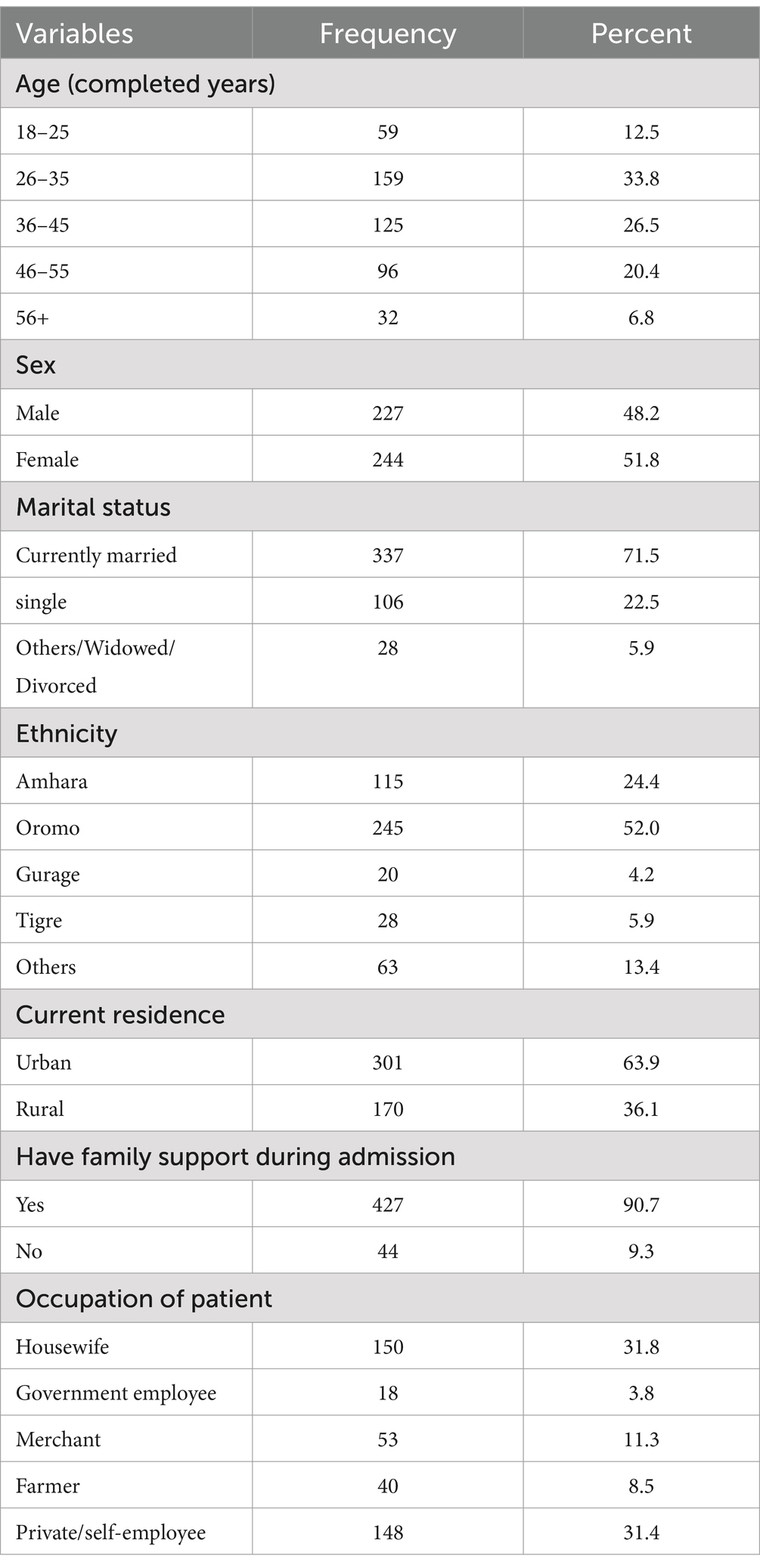
Table 1. Socio-demographic characteristics of admitted patients in public health hospitals of Addis Ababa, Ethiopia, 2023 (n = 471).
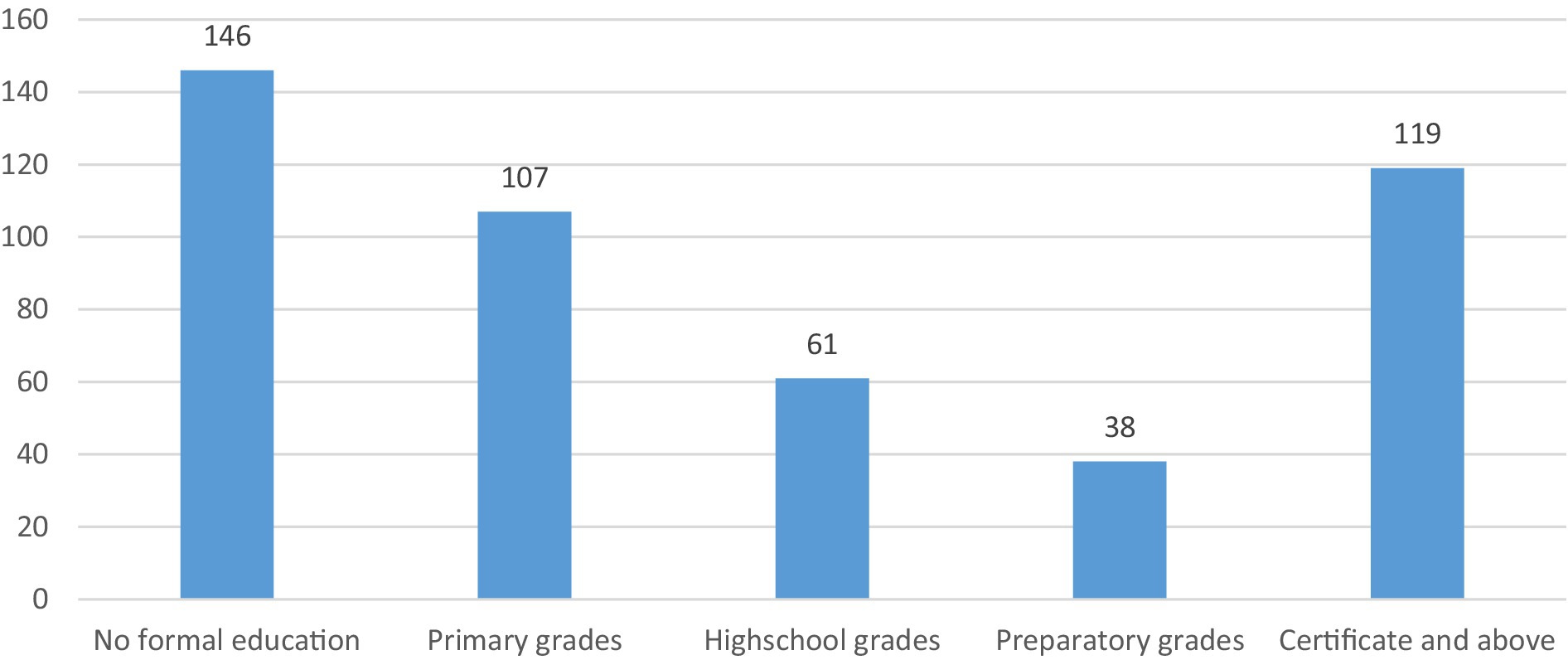
Figure 1. Educational status of patients admitted at public health hospitals of Addis Ababa, Ethiopia, 2023 (N = 471).
Admission characteristics of patients
The average length of stay for patients, indicated by the mean (±SD), was 9.2 (±9.7) days. The majority (43.5%) had stayed in the hospital for 4–7 days, with the next most common duration being 8–14 days. Additionally, a significant portion of participants were from the standard admission rooms (Table 2).
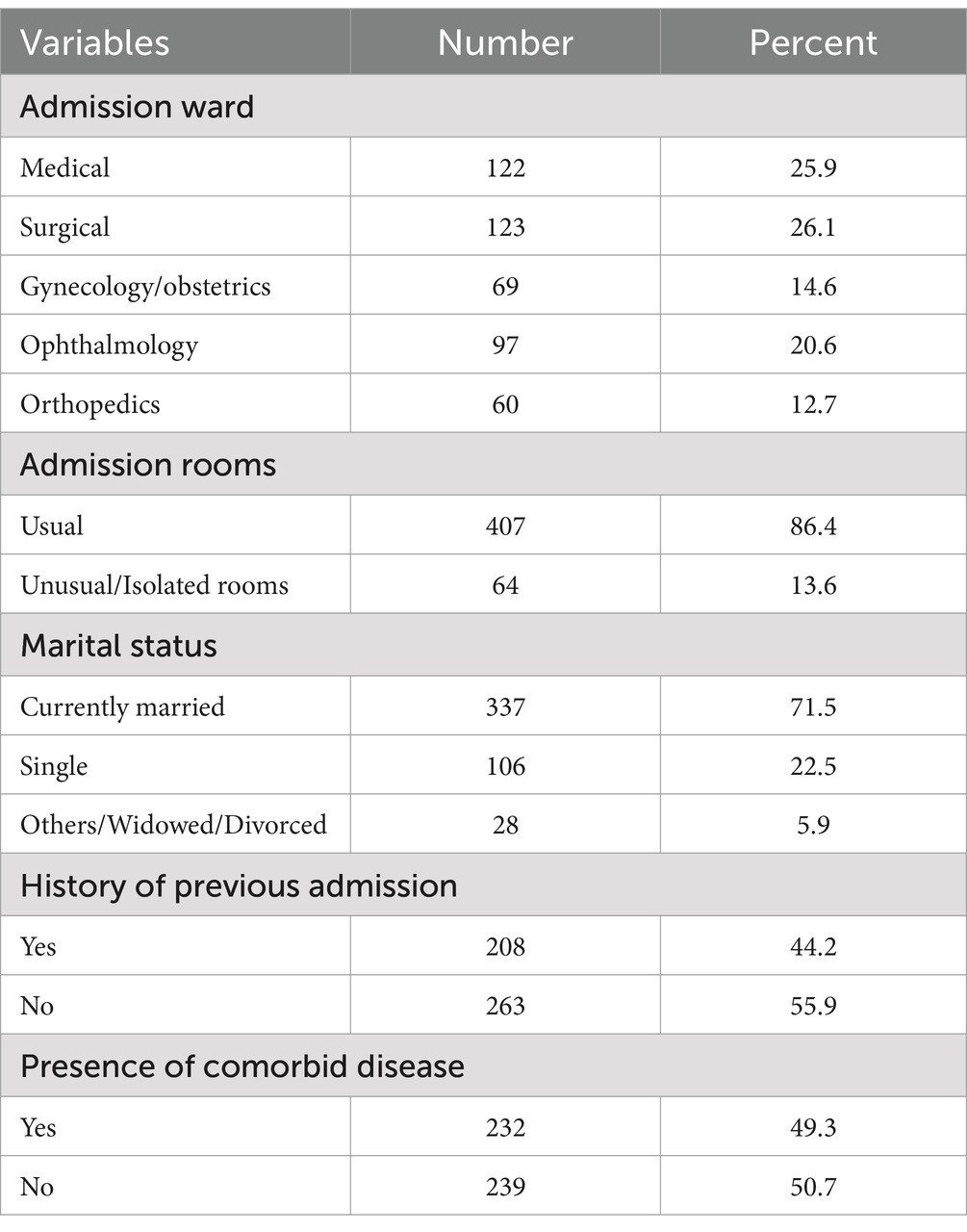
Table 2. Admission characteristics of patients admitted at public health hospitals of Addis Ababa, Ethiopia, 2023.
Newcastle nursing care satisfaction scale scores of patients
In this study, participants were asked to rate their satisfaction using the Newcastle Nursing Care Satisfaction Scale (NNCSS). The results showed that a significant proportion of patients were content with the time nurses spent interacting with them, with 41.4% being quite satisfied and 14.2% very satisfied. However, only 27.0% were very satisfied with the responses from nurses. Additionally, 41.6% of patients reported being barely satisfied with the frequency of nurses checking on their well-being. Concerning patient privacy, only 32.1% of patients were completely satisfied with the privacy provisions during their care (Table 3).
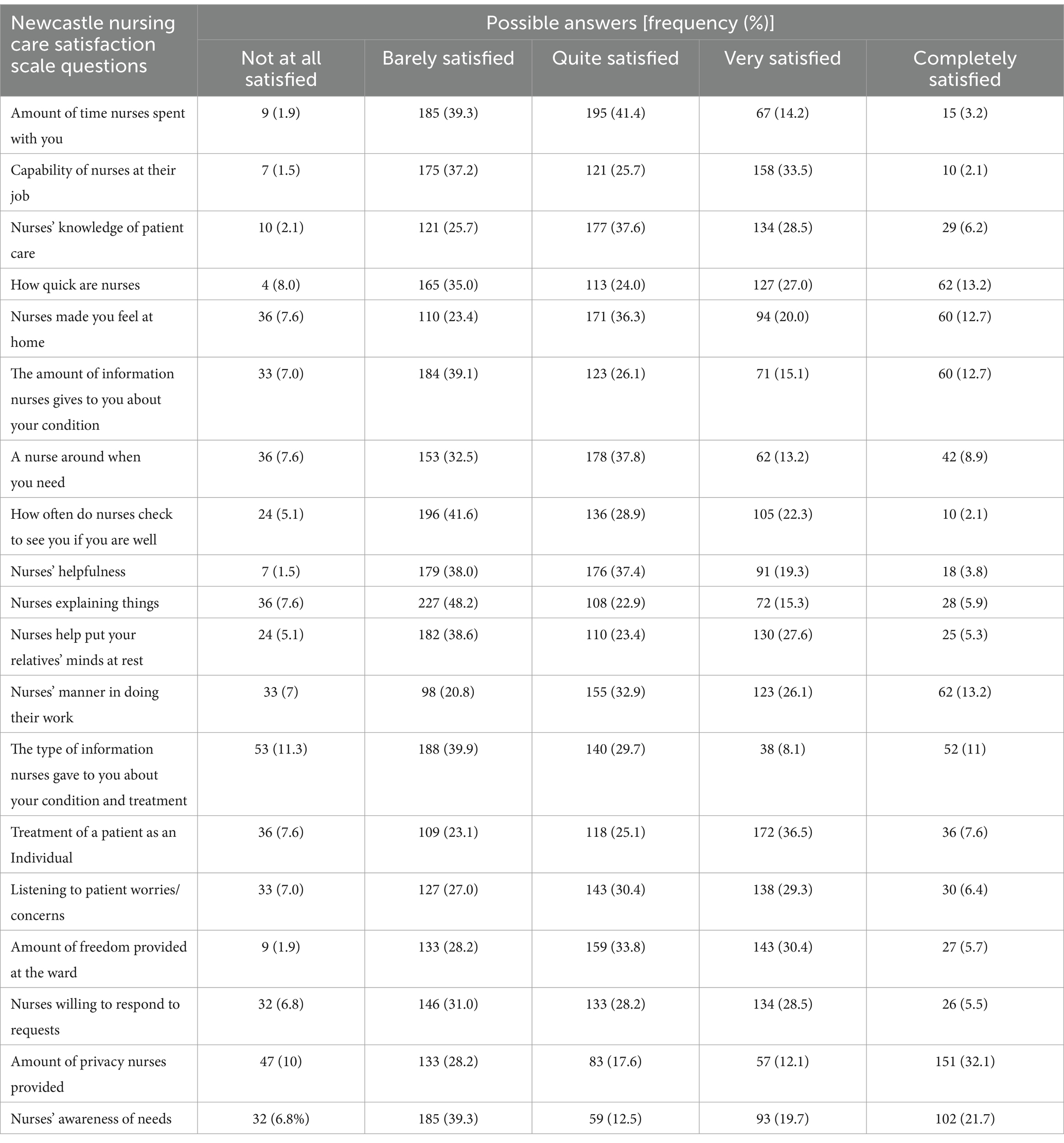
Table 3. Satisfaction of patients admitted at public health hospitals of Addis Ababa based on Newcastle nursing care satisfaction scales (NNCSS) (N = 471).
Prevalence of patient satisfaction
The average score of patient satisfaction, represented by the mean (±SD), was determined to be 36.32 (± 7.4). Following the operational definition outlined in the research, patients were categorized as unsatisfied if they scored below the mean and satisfied if they scored equal to or above it. This classification resulted in 47.8% (95% CI = 42.9, 52.2%) of patients being classified as satisfied (Figure 2).
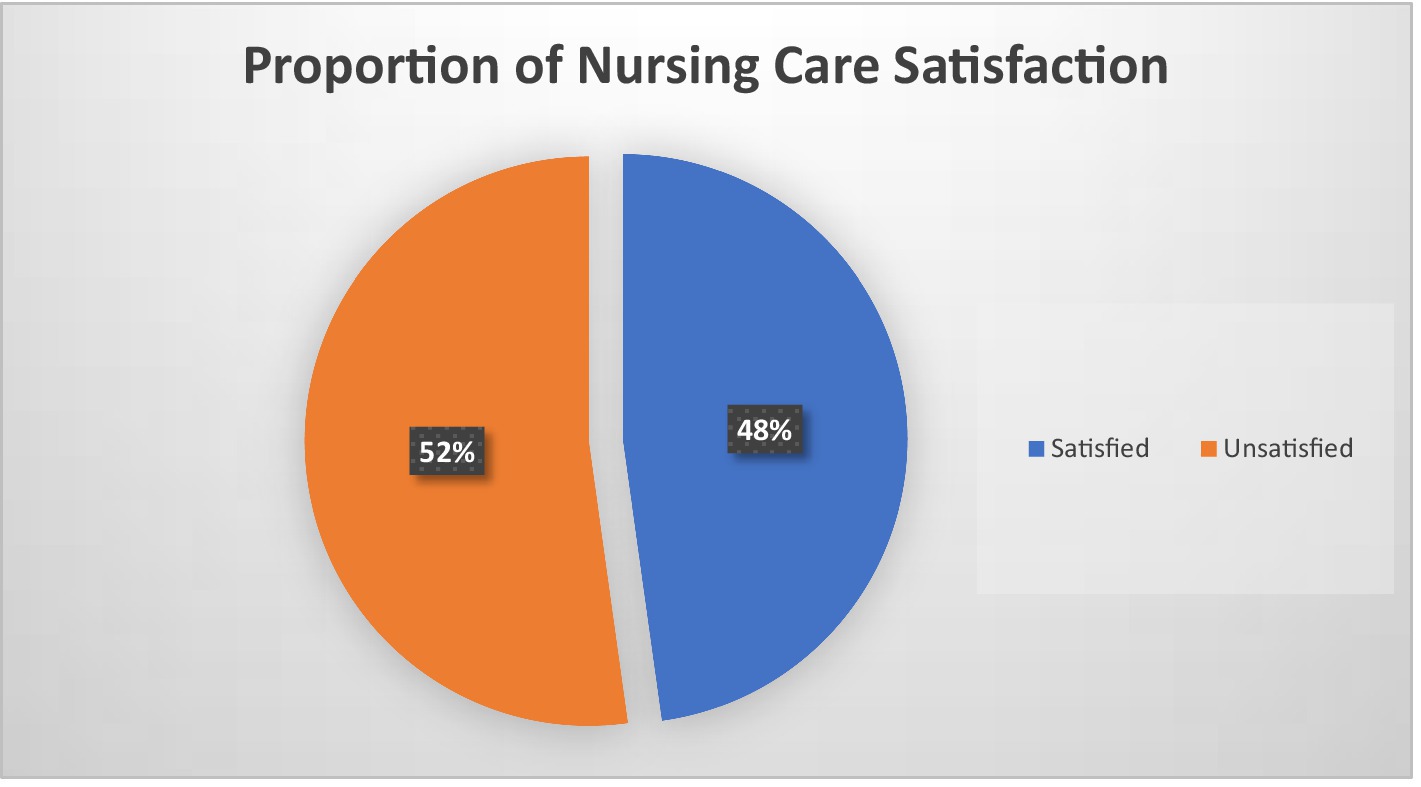
Figure 2. Proportion of nursing care satisfaction among patients admitted at public health hospitals of Addis Ababa, Ethiopia, 2023.
Factors associated with patient satisfaction
The comparison between satisfied and unsatisfied patients revealed distinct factor variables linked to patient satisfaction. Initially, twelve variables, encompassing socio-demographic and admission characteristics, were presumed to be associated with patient satisfaction. Through bivariate analysis, six of these variables demonstrated associations with a p-value less than 0.25, prompting their inclusion in multivariable analysis. In the model, participant in the age group of 26–35 [COR = 0.40 (95% CI: (0.21, 0.73))], 36–45 [COR = 1.96 (95% CI: (1.028, 3.76))], ruler residence [COR = 1.74 (95% CI: (1.188, 2.55))], participant admitted to surgical ward [COR = 3.54 (95% CI: (2.09, 6.0))], obstetrics and gynecology ward [COR = 3.07 (95% CI: (1.66, 5.66))], and patient admitted to ophthalmology ward [COR = 6.0 (95% CI: (3.31, 10.89))], having no history of previous admission [COR = 0.34 (95% CI: (0.23, 0.50))], having no comorbidity [COR = 4.96 (95% CI: (3.35, 7.33))] were found to have a statistically significant positive association with patient nursing care satisfaction.
In the multivariate analysis, participants in the age group of 26–35 were less likely to be satisfied with nursing care [AOR = 0.25, 95% CI: 0.11, 0.56]. Conversely, those admitted to the surgical and orthopedic wards were almost four times more likely to be satisfied with nursing care [AOR = 3.85, 95% CI: 1.98, 7.45]. Additionally, participants within the ophthalmology ward were also around four times more likely to be satisfied with nursing care [AOR = 4.27, 95% CI: 1.81, 10.05].
Having no history of previous admission was associated with lower satisfaction at [AOR = 0.13, 95% CI: 0.07, 0.26] while having comorbidity was strongly associated with higher satisfaction [AOR = 13.4, 95% CI: 7.06, 25.4]. Moreover, the duration of admission also played a significant role in patient satisfaction [AOR = 9.14, 95% CI: 3.46, 24.11]. These factors maintained their significant associations with patient nursing satisfaction in the multivariable analysis (Table 4).
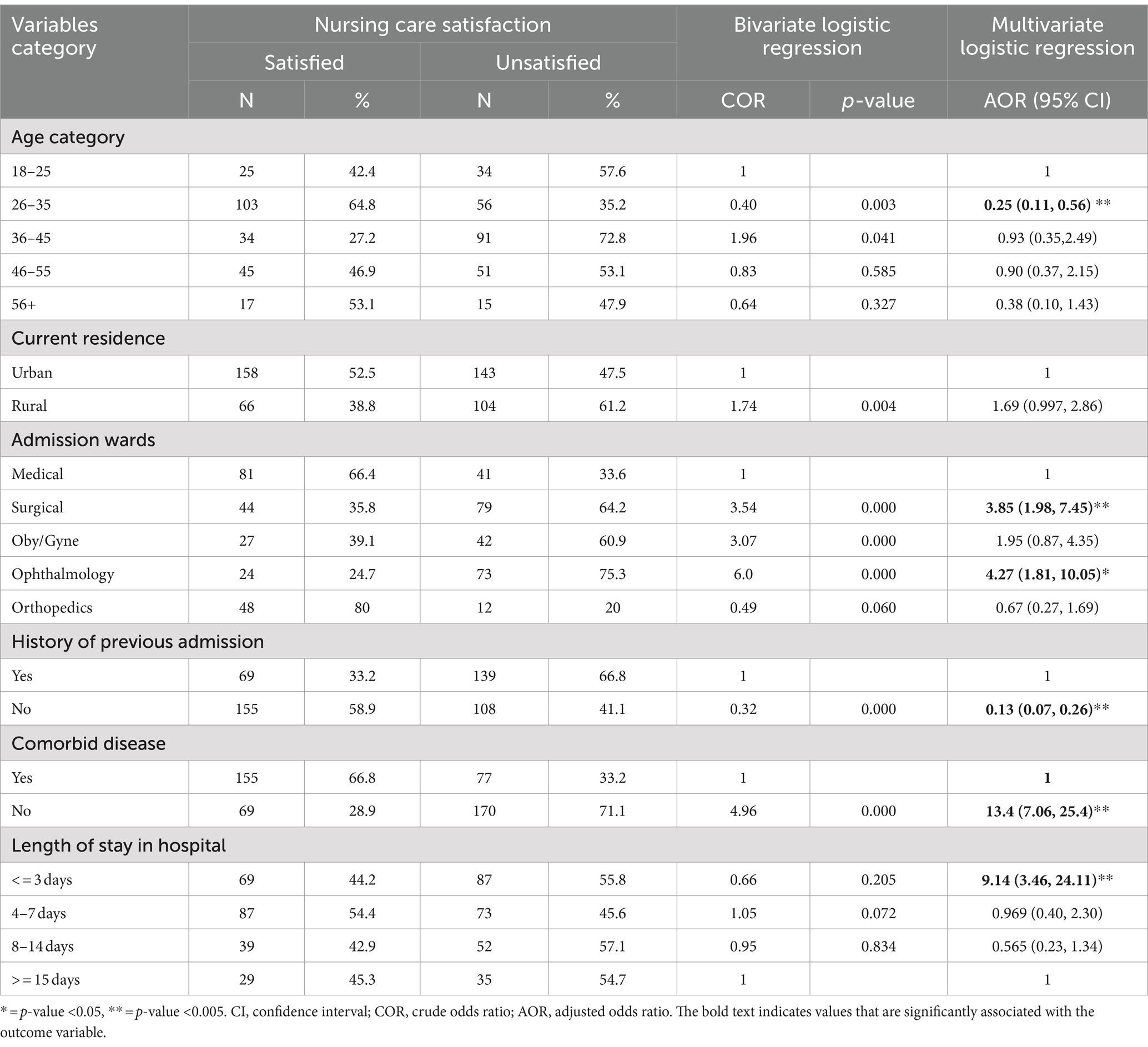
Table 4. Factors associated with nursing care satisfaction among patients admitted at public health hospitals of Addis Ababa, Ethiopia, 2023.
Discussion
Patients’ satisfaction has been used as a significant indicator of quality services provided by health care providers. Consequently, the most important predictor of patients’ overall satisfaction with hospital care is particularly related to their satisfaction with nursing care. The present study aimed to assess the prevalence of patient satisfaction and its associated factors among patients admitted to public hospitals in Addis Ababa city.
The study showed 47.8% of patients were satisfied which means just under one in every two admitted patients were satisfied. The prevalence is almost consistent with the findings in a study conducted at Debre Berhan Hospital that reported 49.2% patient satisfaction (18) and studies done in eastern Ethiopia (52.75%) (23), and the pooled prevalence (55.15%) of patient satisfaction in Ethiopia (5). It is also almost consistent with the study conducted in Menelik II Hospital in 2016 which reported 54.8% patient satisfaction (24).
However, the prevalence was slightly lower than the studies conducted in Dessie Ethiopia, Mizan-Aman, Bonga and Tepi hospitals and Pawie General Hospital, which reported 58.8, 61.3, and 60.8%, respectively (25–27). It is also lower when it compared to a study in Iran that reported 69% satisfaction (28). The difference could be attributed to differences in the socioeconomic status of study participants in different areas. In the case of Iran, the discrepancy might be due to different standards or procedures of patient care. Additionally, this discrepancy may arise from differences in how satisfaction is operationalized and the techniques used to determine satisfaction status. In this study, patient satisfaction was defined using the mean score as a cut-off point.
Several independent variables were indicated to have a significant association with the dependent variable. Multivariate logistic regression showed that patients in the age group 26–35 were 75% less likely to be satisfied with nursing care. This might be possible because to patients aged 26–35 often is the age significant work and family responsibilities are apparent making hospital stays particularly disruptive. This disruption might contribute to lower satisfaction levels. In the present study patients who came from rural areas were more likely satisfied than those from urban areas. The finding is supported by the study done on patient satisfaction in urban and rural areas of Scotland (29). This might be the fact that most patients from rural areas might have lower expectations regarding healthcare services compared to those from urban areas. The other possible explanation is that most rural dweller in Ethiopia enrolled in community-based health insurance (CBHI) (30), so their healthcare expense is covered through these insurers.
Patients with no prior history of admission were about 87% less likely to be satisfied than those who used to have previous history of admission. The possible explanation might be that this group of patients could not have had experiences with admission that their expectations and the standards they found might affected their satisfaction. This is supported by the study conducted at Debre Berhan Hospital (18). Presence of comorbidity disease other than the present admitting case was also a factor that significantly affected patient satisfaction, patients who had no comorbidity were more likely to be satisfied than those who had comorbidity This could be because those patients with other diseases apart from the current health problem need extra nursing care and follow up while those without other comorbidities do not need extra nursing care that allows appropriate, timely and frequent follow up which increase patient satisfaction. This finding is supported by a study conducted at Dessie (25).
Patients admitted in surgical and ophthalmology wards were more likely to be satisfied than patients in others. The findings are in line with the study done at Pawie General Hospital, west Ethiopia, where patients in the surgical ward were about three times more likely to be satisfied (27). This might be due to surgical and ophthalmology procedures often having well-defined goals and measurable outcomes. This clear goal can lead to a sense of accomplishment for patients. The finding that patients with shorter stays (less than or equal to 3 days) reported higher satisfaction aligns with a study done in an Academic Hospital (31). One possible explanation is that patients with shorter stays may have experienced less severe health issues or undergone less invasive treatments, leading to quicker recovery and higher satisfaction levels.
Strengths and limitations
The present study used a standard tool (NWNCSS) to precisely estimate patient satisfaction. The study adds to the knowledge of understanding of patient satisfaction in admitted patients by widening the study setting to two referral hospitals. Data collectors were nurse professionals who could explain the questions adequately which might have increased data quality. Recall biases are unlikely in the present study as information inquired were present experiences.
Regarding limitations, social desirability bias while participants were requested to give accurate information about services provided while receiving care might have influenced the result of the study. However, they were assured that the interview was for the improvement of services. Furthermore, one potential limitation is that the questionnaire was administered by an interviewer rather than through self-administration by the participants. We recommend that future researchers explore solutions to this limitation to enhance the validity of their findings and minimize bias.
Conclusion
Overall, just under one in every two admitted patients were satisfied, indicating areas for potential improvement in nursing care. Specific factors with satisfaction include the age group 26–35 showing lower satisfaction levels, indicating a need for targeted strategies to address their specific needs. While patients in surgical and ophthalmology wards, along with those with no comorbidities and shorter admission durations, reported significantly higher satisfaction levels. These results highlight the importance of considering demographic and clinical factors when developing care strategies. By focusing on these elements, hospitals can improve the quality of nursing care and enhance overall patient satisfaction.
Data availability statement
The original contributions presented in the study are included in the article/supplementary material, further inquiries can be directed to the corresponding author.
Ethics statement
The studies involving humans were approved by Ethical clearance was obtained from the Kea Med Medical College Research Ethics Review Committee. The studies were conducted in accordance with the local legislation and institutional requirements. The participants provided their written informed consent to participate in this study.
Author contributions
DA: Conceptualization, Data curation, Formal analysis, Funding acquisition, Investigation, Methodology, Project administration, Resources, Software, Supervision, Validation, Visualization, Writing – original draft, Writing – review & editing. SM: Conceptualization, Data curation, Formal analysis, Funding acquisition, Investigation, Methodology, Project administration, Resources, Software, Supervision, Validation, Visualization, Writing – original draft, Writing – review & editing. LK: Data curation, Investigation, Methodology, Resources, Supervision, Validation, Writing – original draft, Writing – review & editing. YA: Conceptualization, Data curation, Investigation, Project administration, Supervision, Writing – original draft, Writing – review & editing. KA: Conceptualization, Data curation, Formal analysis, Funding acquisition, Investigation, Methodology, Project administration, Resources, Software, Supervision, Validation, Visualization, Writing – original draft, Writing – review & editing. TA: Conceptualization, Data curation, Formal analysis, Funding acquisition, Investigation, Methodology, Project administration, Resources, Software, Supervision, Validation, Visualization, Writing – original draft, Writing – review & editing.
Funding
The author(s) declare that no financial support was received for the research, authorship, and/or publication of this article.
Acknowledgments
We would like to express our sincere appreciation to Kea Med Medical College for giving us the chance to carry out this study. Also, we would like to express our profound appreciation and thanks to our colleagues for their unwavering advice, practical recommendations, and inspiration that helped us with this endeavor.
Conflict of interest
The authors declare that the research was conducted in the absence of any commercial or financial relationships that could be construed as a potential conflict of interest.
Publisher’s note
All claims expressed in this article are solely those of the authors and do not necessarily represent those of their affiliated organizations, or those of the publisher, the editors and the reviewers. Any product that may be evaluated in this article, or claim that may be made by its manufacturer, is not guaranteed or endorsed by the publisher.
References
1. Aiken, LH, Sloane, DM, Ball, J, Bruyneel, L, Rafferty, AM, and Griffiths, P. Patient satisfaction with hospital care and nurses in England: an observational study. BMJ Open. (2021) 8:e019189. doi: 10.1136/bmjopen-2017-019189
2. Gavurova, B, Dvorsky, J, and Popesko, B. Patient satisfaction determinants of inpatient healthcare. Int J Environ Res Public Health. (2021) 18:11337. doi: 10.3390/ijerph182111337
3. Negarandeh, R, Bahabadi, AH, and Mamaghani, JA. Impact of regular nursing rounds on patient satisfaction with nursing care. Asian Nurs Res. (2014) 8:282–5. doi: 10.1016/j.anr.2014.10.005
5. Mulugeta, H, Wagnew, F, Dessie, G, Biresaw, H, and Habtewold, TD. Patient satisfaction with nursing care in Ethiopia: a systematic review and meta-analysis. BMC Nurs. (2019) 18:1–12. doi: 10.1186/s12912-019-0348-9
6. Buchanan, J, Dawkins, P, and Lindo, JL. Satisfaction with nursing care in the emergency department of an urban hospital in the developing world: a pilot study. Int Emerg Nurs. (2015) 23:218–24. doi: 10.1016/j.ienj.2015.01.001
7. Jakimowicz, S, Perry, L, and Lewis, J. Insights on compassion and patient-centred nursing in intensive care: a constructivist grounded theory. J Clin Nurs. (2018) 27:1599–611. doi: 10.1111/jocn.14231
8. Labrague, LJ, de los Santos, JAA, Tsaras, K, Galabay, JR, Falguera, CC, Rosales, RA, et al. The association of nurse caring behaviours on missed nursing care, adverse patient events and perceived quality of care: a cross-sectional study. J Nurs Manag. (2020) 28:2257–65. doi: 10.1111/jonm.12894
9. Kalaja, R. Determinants of patient satisfaction with health care: a literature review. Eur J Nat Sci Med. (2023) 6:43–54. doi: 10.2478/ejnsm-2023-0005
10. Lemmen, C, Simic, D, and Stock, S. A vision of future healthcare: potential opportunities and risks of systems medicine from a citizen and patient perspective—results of a qualitative study. Int J Environ Res Public Health. (2021) 18:9879. doi: 10.3390/ijerph18189879
11. Goudarzi, F, Pour, FJ, Hasanvand, S, Ebrahimzadeh, F, and Kvist, T. Patients' satisfaction with humane care in critical care units. Iran J Nurs Midwifery Res. (2021) 26:455–61. doi: 10.4103/ijnmr.IJNMR_88_20
12. Michel, O, Garcia Manjon, AJ, Pasquier, J, and Ortoleva, BC. How do nurses spend their time? A time and motion analysis of nursing activities in an internal medicine unit. J Adv Nurs. (2021) 77:4459–70. doi: 10.1111/jan.14935
13. Stimpfel, AW, Sloane, DM, and Aiken, LH. The longer the shifts for hospital nurses, the higher the levels of burnout and patient dissatisfaction. Health Aff. (2012) 31:2501–9. doi: 10.1377/hlthaff.2011.1377
14. Westbrook, JI, Duffield, C, Li, L, and Creswick, NJ. How much time do nurses have for patients? A longitudinal study quantifying hospital nurses' patterns of task time distribution and interactions with health professionals. BMC Health Serv Res. (2011) 11:1–12. doi: 10.1186/1472-6963-11-319
15. Eyasu, KH, Adane, AA, Amdie, FZ, Getahun, TB, and Biwota, MA. Adult patients’ satisfaction with inpatient nursing care and associated factors in an Ethiopian referral hospital, northeast, Ethiopia. Adv Nurs. (2016) 2016:1–7. doi: 10.1155/2016/6308617
16. Eshetie, G, Feleke, A, and Genetu, M. Patient satisfaction and associated factors among outpatient health service users at primary hospitals of North Gondar, Northwest Ethiopia, 2016. Adv Public Health. (2020) 2020:1–8. doi: 10.1155/2020/6102938
17. Batbaatar, E, Dorjdagva, J, Luvsannyam, A, Savino, MM, and Amenta, P. Determinants of patient satisfaction: a systematic review. Perspect Public Health. (2017) 137:89–101. doi: 10.1177/1757913916634136
18. Sharew, NT, Bizuneh, HT, Assefa, HK, and Habtewold, TD. Investigating admitted patients’ satisfaction with nursing care at Debre Berhan referral Hospital in Ethiopia: a cross-sectional study. BMJ Open. (2018) 8:e021107. doi: 10.1136/bmjopen-2017-021107
19. Wudu, MA. Predictors of adult patient satisfaction with inpatient nursing care in public hospitals of eastern Amhara region, northeastern Ethiopia. Patient Prefer Adherence. (2020) 15:177–85. doi: 10.2147/PPA.S294041
20. Kasa, AS, and Gedamu, H. Predictors of adult patient satisfaction with nursing care in public hospitals of Amhara region, Northwest Ethiopia. BMC Health Serv Res. (2019) 19:52. doi: 10.1186/s12913-019-3898-3
21. Miruts, G, and Asfaw, M. The implementation of civil service reforms in Ethiopia: the Woreda-net as a sole promoter to implement civil service reform of Tigray National Regional State. Civ Environ Res. (2014) 6, 95–102.
22. Von Elm, E, Altman, DG, Egger, M, Pocock, SJ, Gøtzsche, PC, and Vandenbroucke, JP. The strengthening the reporting of observational studies in epidemiology (STROBE) statement: guidelines for reporting observational studies. Lancet. (2007) 370:1453–7. doi: 10.1016/S0140-6736(07)61602-X
23. Ahmed, T, Assefa, N, Demisie, A, and Kenay, A. Levels of adult patients’ satisfaction with nursing care in selected public hospitals in Ethiopia. Int J Health Sci. (2014) 8:375–83. doi: 10.12816/0023994
24. Getachew, G, and Berhe, D. Why patients are dissatisfied on nursing care services at menelik hospital, Addis ababa. J Innov Assoc. (2016) 5:850–60.
25. Edmealem, A, Asfaw, Y, Ademe, S, and Tegegne, B. Patients’ satisfaction and associated factors towards nursing care in Dessie referral hospital, Northeast Ethiopia. Clin J Nurs Care Pract. (2019) 1:13–9. doi: 10.29328/journal.cjncp.1001018
26. Shewasinad, S, and Sayih, A. Assessment of adult patient satisfaction and associated factors with nursing care among admitted patients in medical, surgical, obstetrics and gynecology ward in Mizan-Aman general hospital, Bonga and tepi hospitals, Southwest Ethiopia 2016. Nurs Health Care. (2018) 8:1–9. doi: 10.19080/JOJNHC.2018.08.555748
27. Aga, TB, Ferede, YM, and Mekonen, EG. Satisfaction and associated factors towards inpatient health care services among adult patients at Pawie general hospital, West Ethiopia. PLoS One. (2021) 16:e0249168. doi: 10.1371/journal.pone.0249168
28. Farahani, MF, Shamsikhani, S, and Hezaveh, MS. Patient satisfaction with nursing and medical care in hospitals affiliated to arak university of medical sciences in 2009. Nurs Midwifery Stud. (2014) 3:e14022. doi: 10.17795/nmsjournal14022
29. Iqbal, I, Thompson, L, and Wilson, P. Patient satisfaction with general practice in urban and rural areas of Scotland. Rural Remote Health. (2021) 21:6634. doi: 10.22605/RRH6634
30. Abdilwohab, MG, Abebo, ZH, Godana, W, Ajema, D, Yihune, M, and Hassen, H. Factors affecting enrollment status of households for community based health insurance in a resource-limited peripheral area in southern Ethiopia. Mixed method. PloS One. (2021) 16:e0245952. doi: 10.1371/journal.pone.0245952
Keywords: patient satisfaction, nursing care, inpatients, health care professionals, quality improvement
Citation: Abebe D, Mesfin S, Kenea LA, Alemayehu Y, Andarge K and Aleme T (2024) Patient satisfaction and associated factors in Addis Ababa’s public referral hospitals: insights from 2023. Front. Med. 11:1456566. doi: 10.3389/fmed.2024.1456566
Edited by:
Olga Ribeiro, Escola Superior de Enfermagem do Porto, PortugalReviewed by:
Abílio Cardoso Teixeira, Santa Maria Higher School of Health, PortugalTânia Lourenço, Escola Superior de Enfermagem de São José de Cluny, Portugal
Ricardo Melo, Escola Superior de Enfermagem da Cruz Vermelha Portuguesa de Oliveira de Azeméis, Portugal
Copyright © 2024 Abebe, Mesfin, Kenea, Alemayehu, Andarge and Aleme. This is an open-access article distributed under the terms of the Creative Commons Attribution License (CC BY). The use, distribution or reproduction in other forums is permitted, provided the original author(s) and the copyright owner(s) are credited and that the original publication in this journal is cited, in accordance with accepted academic practice. No use, distribution or reproduction is permitted which does not comply with these terms.
*Correspondence: Dawit Abebe, ZGF3aXRtZmg4MUBnbWFpbC5jb20=
 Dawit Abebe
Dawit Abebe Sinetibeb Mesfin
Sinetibeb Mesfin Luna Abebe Kenea3
Luna Abebe Kenea3 Temsegen Aleme
Temsegen Aleme